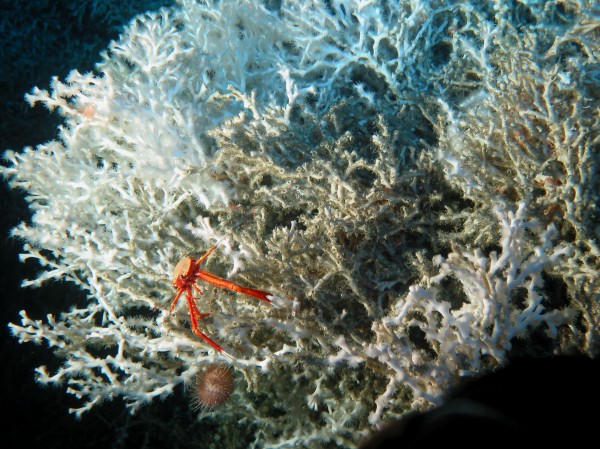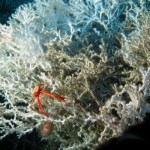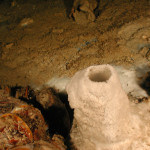This is a tale of cause and effect in the deep sea woven by threads of hypotheses held together by the loom of targeted sampling efforts and multiple lines of evidence. You see, dear readers, once upon a time existed an observation. Hovland (1989) noticed along the Norwegian coastline that carbonate reefs occurred in sediment laden with detectable concentrations of methane and oil. This led him to suggest that
“such reefs form at locations containing high concentrations of bacteria and other microorganisms suspended in the water column as a result of seeping fluids (solutions and gases) that provide some of the energy basis and carbon source for ecosystems independently of photosynthesis.”
Over the course of the last 20 years that hypothesis has been refined by several lines of evidence to suggest that
“the coral reef is located at this exact location due to sub-surface hydrogeologic properties, i.e. that there is an upward seepage of hydrocarbon-charged porewater on which bacteria and other micro-organisms thrive, thus providing suspension-feeders, including the corals, with a substantial and reliable food source.” (Hovland & Thomsen 1997)
This is known as the “hydraulic theory” for reef occurrence. My colleague and former labmate Erin Becker just published a study which sheds more light on the coral-seep relationship.
Lophelia pertusa community in the deep Gulf of Mexico. Photo from the NOAA Photo Library (click image) and available in the public domain.
For the last several years I’ve had the unfortunate circumstance of cooking with electric stoves. Just last February, my wife and I bought our first house and moved in. Now, we are blessed with a propane line and have the wonders of clean burning fire at my culinary disposal. But it turns out I’m not the only organism that prefers to use gas. In the deep Gulf of Mexico lurks a secret underground society of gasiverous microbes! There bacteria and archaea work in concert to utilize methane and hydrogen sulfide (rotten egg gas) as an energy source and carbon backbone for building metabolites. The byproduct of this microbial consortia results in the carbonates. In other words, these microbes essentially ‘poop’ out rock!
Becker and colleagues studied if the deep sea coral Lophelia pertusa occurs near active oil and gas seeps because it eats organisms associated with the seepage. The carbonate outcrops dot the seafloor landscape around continental margins and provide a roost for other animals like corals and barnacles. These animals like to take advantage of being positioned above the seafloor in order to capture food in the water. Perhaps the methane seeps provided a wealth of locally derived primary production of essential nutrients in the form of particulate matter. If sessile, filter-feeding animals are located in the right place they might surely take advantage of seep-derived mana from the abyssal heavens.
To understand if corals and the animals, such as crabs and polychaete worms, are fueled on gas the authors looked at the tissue stable isotope concentrations for carbon, nitrogen and sulfur – all important elements that are obtained from eating other stuff. Stable isotopes are useful tracers of an animal’s last meal. The old adage “you are what you eat” is actually true to some extent. Each animal has a slightly different signature of stable isotope ratios that reflect the signature of its food item. This cascades down to the primary producer that was able to fix inorganic carbon from carbon dioxide or methane into simple sugars or other metabolites. For instance, many cnidarians capture copepods with their stinging cells, called nematocysts. If that is mostly what they eat then the coral’s tissue would have stable C, N, and S ratios that were similar to the prey. Likewise, if that copepod ate an alga, then its tissue stable isotope concentrations would resemble the alga’s. The alga is a photosynthesizer and fixes carbon dioxide using solar energy. The original stable isotope values depend on the source of inorganic carbon and the metabolic pathway the carbon molecules were shoved through. This is called fractionation. Carbon has the stable isotopes C-12 and C-13. C-12 is lighter and moves through most metabolic pathways more quickly than the slightly heavier C-13. Therefore most animal tissues are “depleted” in C-13 relative to C-12.
Biologists can exploit the difference in fractionation to determine potential food sources for the animals. The process by which methane is fixed by chemosynthesis versus carbon dioxide is fixed by photosynthesis can produce vastly different values. The same process works for sulfur, where the oxidation of sulfides is used as an energy source to fix inorganic carbon. Nitrogen is a little more complicated but is useful as a food web tracer. Each isotope fractionates in predictable ways that has been tested hundreds of times in decades of literature (with caveats of course…). That is, every time a critter eats another critter and transforms the tissue of the prey into fat reserves, muscle mass, etc. the stable isotope signature of the prey is incorporated in the biomass of the predator, but the values shift in predictable ways that correspond to trophic levels.
Becker and colleagues found that while coral communities shared several of the same animals found at seep communities, the tissue stable isotope values of the coral and its inhabitants did not reflect a strong signature characteristic of a gas-fueled ecosystem. One exception was a small snail called Provanna sculpta, which had much more depleted C-13/C-12 ratios than the other coral fauna and reflected a metabolic pathway based on oxidation of hydrogen sulfide. This finding could mean that this snail has chemoautotrophic endosymbionts, a condition found in some close relatives in the Provannidae.
But perhaps early in the coral’s life history, during settlement and its initial growth stages, the coral was reliant on seep primary production. The coral skeleton is a record of its history. It tells a story along the length of its intertwining branches. In this living book are chapters on oxygen concentrations, temperatures, and food sources depending on the isotopes being used.
Becker and colleagues took samples along the length of the coral, from the base where the young coral larvae once settled and attached itself to the carbonate to the tips where the only evidence of active growth remain. Two results stood out. First, there was no indication of seep derived stable isotope signatures in even the most basal part of the skeleton. Second, there was no difference from the base to the tip in isotope signatures suggesting that settlement occurs after active seepage has passed. Additionally, the signatures of the carbonate rock it settled upon were different from Lophelia’s skeleton indicating that it was derived from gas-fueled or other microbial processes.
So does this turn the burner off of the flames of the hypothesis linking deep sea corals to methane seeps? While the corals in the Gulf of Mexico do not rely upon chemosynthetic primary production, they do thrive from its byproducts. Deep sea corals support communities similar to those of seep tubeworms, defined by high standing stock biomass, high abundance of associated fauna and similar species composition. This is more telling of the community. It is not endemic to seeps but can thrive in nonchemosynthetic-based ecosystems as well. In their words:
L. pertusa communities rival adjacent vestimentiferan associated communities in biomass and abundance of the associated fauna. We have long known that the high biomass assemblages of seep fauna are possible because of abundant local primary production fueled by migrating hydrocarbons in the otherwise nutrient-poor deeps-sea environment. Although L. pertusa often colonized carbonate that was only meters away from vestimentiferan aggregations, the results of this study show that the occurrence of L. pertusa at seep sites in the Northern Gulf of Mexico is not primarily due to reliance upon seep-derived nutrition, as hypothesized in the hydraulic theory (Hovland and Mortensen, 1999 [KZ note-but see Hovland & Thomsen 1997 for their ideas in an english language paper]). Rather, seep-induced features such as carbonate occurrence and uneven bottom topography provide appropriate substrate and may drive other processes relating to provision of food, such as current acceleration, bottom mixing, and nutrient concentration.
References:
Becker, E., Cordes, E., Macko, S., & Fisher, C. (2009). Importance of seep primary production to Lophelia pertusa and associated fauna in the Gulf of Mexico Deep Sea Research Part I: Oceanographic Research Papers, 56 (5), 786-800 DOI: 10.1016/j.dsr.2008.12.006
Hovland, M. (1989). Do carbonate reefs form due to fluid seepage? Terra Nova, 2 (1), 8-18 DOI: 10.1111/j.1365-3121.1990.tb00031.x
Hovland, M., Mortensen, P.B., 1999. Norske korallrev og prosesser i havbunnen (Norwegian coral reefs and seabed processes). Bergen 167 pp.
Hovland, M. & Thomsen, E. (1997). Cold-water corals—are they hydrocarbon seep related? Marine Geology, 137 (1-2), 159-164 DOI: 10.1016/S0025-3227(96)00086-2
Hovland, M. (2003). Do Norwegian deep-water coral reefs rely on seeping fluids? Marine Geology, 198 (1-2), 83-96 DOI: 10.1016/S0025-3227(03)00096-3







How do I subscribe to this?
Thanks.
Andy
Would you like to subscribe to our post feed? Go to our sidebar and click on the orange icon that says “Subscribe!”. It will take you to a webpage where you can choose your favorite RSS aggregator to read us in, or you can copy the subscription link from “View feed XML” and paste into your email program or web browser.
Email us (on contact page) if you have any problems!
is it true that a deep sea coral was discovered by scientist that could kill cancer cells.i am doing research on it. if you have any info on sub.could you e-mail to me. THANK YOU,ALBERT.